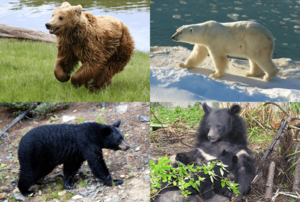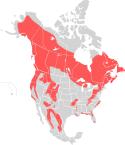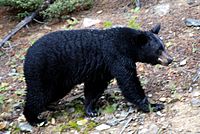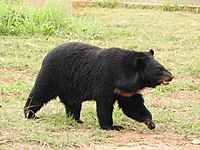Ursus (mammal) facts for kids
Quick facts for kids Ursus (mammal) |
|
|---|---|
 |
|
| From top to bottom: brown bear, American black bear, polar bear, Asian black bear | |
| Scientific classification |
|
| Kingdom: | Animalia |
| Phylum: | Chordata |
| Class: | Mammalia |
| Order: | Carnivora |
| Family: | Ursidae |
| Subfamily: | Ursinae |
| Tribe: | Ursini |
| Genus: | Ursus Linnaeus, 1758 |
| Type species | |
| Ursus arctos Linnaeus, 1758
|
|
| Species | |
|
|
| Synonyms | |
|
|
Ursus is a group of animals, also called a genus, within the bear family (known as Ursidae). This group includes some of the most well-known bears around the world. You might recognize them as the brown bear, the polar bear, the American black bear, and the Asian black bear. The name Ursus comes from a Latin word that simply means bear.
Contents
Meet the Bears of the Ursus Group
This section introduces the main types of bears that belong to the Ursus genus. These bears live in different parts of the world and have unique features.
| Common Name and Scientific Name | Picture | Where They Live |
|---|---|---|
| American black bear Ursus americanus |
 |
|
| Brown bear Ursus arctos |
 |
|
| Polar bear Ursus maritimus |
 |
|
| Asian black bear Ursus thibetanus |
 |
Sometimes, different types of bears can have cubs together. For example, a mix between a grizzly bear (a type of brown bear) and a polar bear has been seen. These special bears are often called "pizzly" or "grolar" bears. Their official name is a grizzly–polar bear hybrid.
Ancient Bears: Fossil Records
Scientists have found fossils of many ancient bears that also belong to the Ursus group. These fossils help us understand how bears have changed over millions of years.
Some of these extinct bears include:
- †Ursus deningeri
- †Ursus etruscus
- †Ursus minimus
- †Ursus spelaeus (the famous cave bear)
Bear Reproduction and Life Cycle
Bears are mostly solitary animals, meaning they live alone for much of their lives. However, they come together to find partners and have cubs. Both male and female bears often mate with more than one partner. They use different ways to find mates and have healthy cubs.
Finding a Mate
Bears need large areas to roam to find other bears during mating season. Because female bears take a long time to raise their cubs, there are usually more male bears looking for partners. This means females can be choosier about who they mate with. Males often compete with each other to win over a female.
The mating season for many Ursus bears, like American black bears, brown bears, and polar bears, usually happens in spring and summer (around May to July).
Cubs and Family Life
After mating, the female bear's body has a special way of delaying the cub's development. This is called "delayed implantation." The cub only starts to grow properly in late fall (around November). The cubs are then born in the den during early winter (around January).
Female bears usually mate with three to four different males during a mating season. Male bears might mate with one to eight females. Older and larger male bears are often more successful at finding mates because they can compete better.
Bears don't have a strict social order like some other animals. When many bears gather in one place, like at a food source, they might show who is stronger based on their size or how aggressive they are. But generally, bears are quite independent, especially when it comes to finding a mate. During the breeding season, both male and female bears will travel more widely to increase their chances of meeting a partner. Males often roam large areas, using their sense of smell to find females ready to mate.
Images for kids
See also
 In Spanish: Ursus para niños
In Spanish: Ursus para niños









